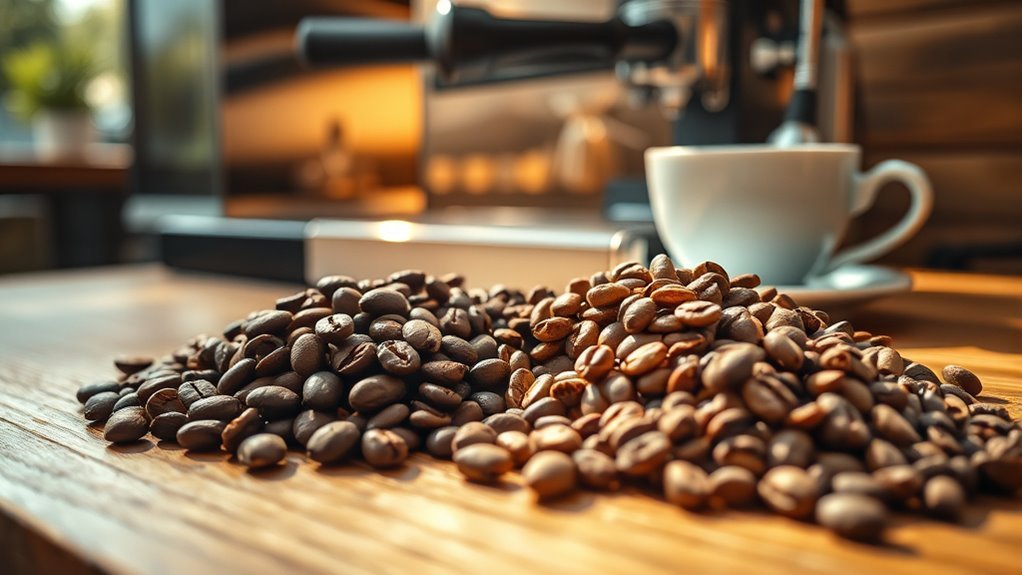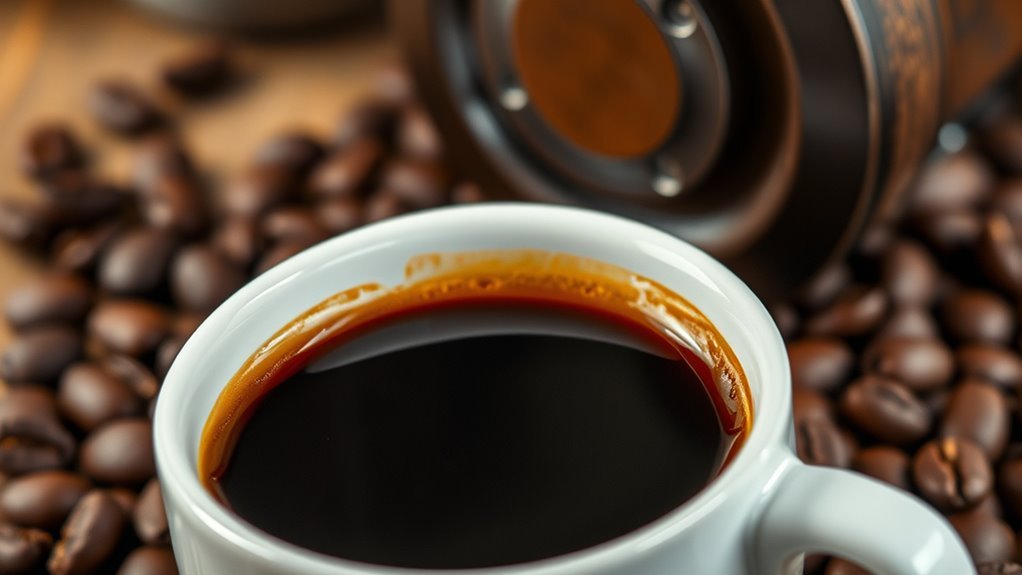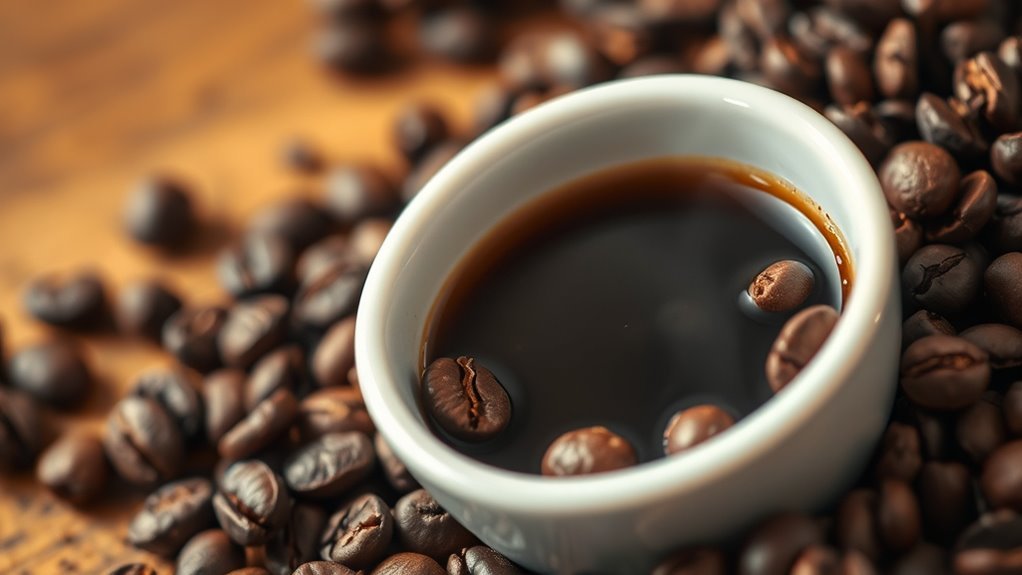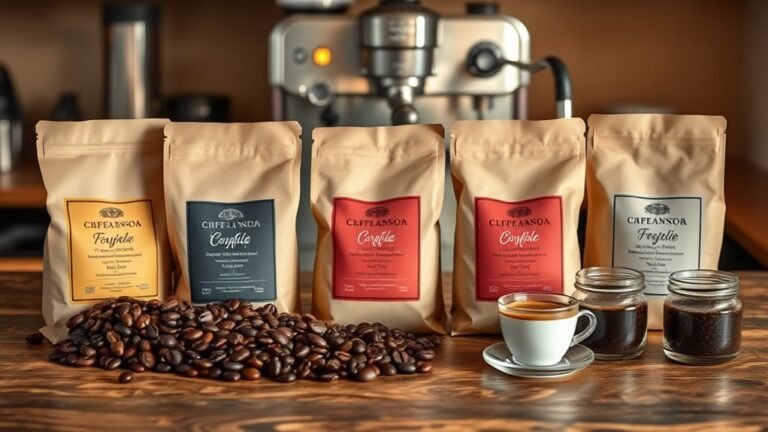Can Regular Coffee Beans Be Used for Espresso
Yes, you can use regular coffee beans for espresso, but achieving the best flavor requires careful attention to grind size and roast levels. Ideally, medium to dark roast beans are recommended, as they provide richer flavors. You’ll need to guarantee your espresso machine is set for proper temperature and pressure, and consistent tamping is essential for even extraction. By experimenting with grind size and brewing time, you can enhance your espresso experience even further. There’s much more to explore!
Understanding Espresso Beans vs. Regular Coffee Beans

When you explore the world of coffee, it’s essential to understand the differences between espresso beans and regular coffee beans. Espresso characteristics fundamentally stem from how the beans are processed and brewed. Espresso typically requires a fine grind, which enhances the extraction of flavors and oils during the brewing process, resulting in a concentrated shot. Regular coffee beans, often coarser, yield a milder flavor profile suitable for drip brewing.
Bean varieties also play a key role; Arabica beans are often used for espresso due to their complex flavors, while Robusta can add a richer crema and caffeine punch. By grasping these distinctions, you’ll appreciate how specific beans and preparation methods influence your coffee experience, empowering your brewing freedom.
The Roasting Process and Its Impact on Flavor
The roasting process is essential in defining the flavor profile of coffee beans, influencing everything from acidity to sweetness. Different roast levels create distinct chemical reactions that affect flavor development, which directly impacts how the coffee extracts during brewing. Understanding these factors can help you choose the right beans for your espresso and optimize your brewing technique.
Roast Levels Explained
Understanding roast levels is essential if you want to appreciate how the roasting process influences flavor profiles in coffee. Coffee typically ranges from light roast to dark roast, each offering distinct characteristics. A light roast preserves more of the bean’s original flavors, resulting in brighter acidity and floral notes. It’s often preferred for its nuanced complexity. On the other hand, a dark roast emphasizes boldness, with deeper, richer flavors and a lower acidity. The sugars caramelize more in darker roasts, leading to bitter and smoky undertones. Knowing these differences helps you select the right beans for espresso, as each roast level can drastically alter the brewing outcome and overall experience. Choose wisely based on your flavor preferences.
Flavor Development Factors
Roasting not only determines the level of a coffee bean’s color and texture but also plays a pivotal role in flavor development. As you roast, chemical reactions occur that transform the bean’s structure and release volatile compounds, shaping the flavor profiles you experience. The Maillard reaction and caramelization contribute to a complex array of aromas and tastes, influencing your sensory perception. Lighter roasts tend to highlight acidity and fruity notes, while darker roasts emphasize bitterness and body. Understanding these nuances allows you to appreciate the depth of flavor in your espresso. By adjusting roast levels, you can manipulate the flavor profiles to suit your personal preferences, offering a sense of freedom in your coffee journey.
Impact on Extraction
As you explore the nuances of coffee extraction, it becomes clear that the roasting process greatly influences how flavors are drawn from the beans. The degree of roast can considerably affect extraction efficiency and flavor balance, impacting your espresso experience. Lighter roasts may yield brighter acidity, while darker roasts often produce a heavier body with deeper flavors.
| Roast Level | Extraction Efficiency | Flavor Balance |
|---|---|---|
| Light Roast | High | Bright, Fruity |
| Medium Roast | Moderate | Balanced, Sweet |
| Dark Roast | Lower | Bold, Bittersweet |
Understanding these dynamics allows you to choose beans that align with your desired espresso profile, providing freedom to explore various flavor dimensions.
Flavor Extraction: How Brewing Methods Differ
While various brewing methods can yield vastly different flavor profiles, the underlying principles of flavor extraction remain consistent across them. Each brewing technique—be it espresso, pour-over, or French press—utilizes extraction variables like water temperature, grind size, and brew time to influence the resulting taste. For espresso, the high pressure and short extraction time emphasize rich, concentrated flavors, while methods like cold brew extract smoother, less acidic notes over an extended period. The choice of coffee beans also plays a vital role; regular beans can produce distinct flavors if brewed correctly. Understanding these variables empowers you to explore the potential of each brewing technique, ultimately allowing for a more personalized coffee experience.
Tips for Brewing Espresso With Regular Coffee Beans

Brewing espresso with regular coffee beans can yield impressive results when the right techniques are employed. First, focus on bean selection; choose high-quality, freshly roasted coffee that complements your taste preferences. Look for beans with a medium to dark roast, as they often provide the rich flavors desired in espresso. Next, pay attention to brewing techniques. Verify your espresso machine is properly calibrated, maintaining the correct temperature and pressure for ideal extraction. Use a consistent tamping pressure to guarantee even water distribution through the coffee puck. Finally, monitor your brew time closely; it should typically range from 25 to 30 seconds. By refining these aspects, you can create a satisfying espresso experience, even with regular coffee beans.
Experimenting With Grind Size and Brewing Time
Finding the right grind size and brewing time is essential for extracting the best flavors from regular coffee beans when making espresso. Start by making small grind adjustments; a finer grind typically results in a richer extraction, while a coarser grind can lead to a quicker brew. Conduct brewing experiments by varying the time you allow the water to interact with the coffee. Aim for a 25-30 second extraction, but be prepared to tweak this based on your grind size. If the espresso tastes bitter, consider coarsening the grind or shortening the brew time. Conversely, if it’s sour, try a finer grind or a longer extraction. Balancing these variables will lead you to a satisfying espresso experience.
Tasting Notes: What to Expect From Your Espresso Shot

When you take a sip of your espresso shot, you’ll likely notice a complex interplay of flavors and aromas that can reveal much about the coffee beans used. The flavor profiles can range from fruity and floral to nutty and chocolatey, depending on the origin and roast level of the beans. A well-extracted shot will present a rich crema, enhancing the tasting experience by adding a velvety texture. You’ll also detect varying acidity levels, which can brighten or dull the overall flavor. The balance between sweetness and bitterness plays a vital role, too, creating a harmonious finish. By understanding these nuances, you can appreciate the artistry behind espresso, allowing for a more liberated exploration of your coffee journey.
Frequently Asked Questions
Can I Use Decaf Coffee Beans for Espresso?
Absolutely, you can use decaf coffee beans for espresso. Decaf espresso offers a unique flavor profile that can be just as rich and complex as its caffeinated counterpart. While the extraction process remains similar, the absence of caffeine might slightly alter the taste experience. If you’re seeking a robust shot without the jitters, experimenting with decaf can lead to delightful discoveries in flavor nuances that cater to your preference for freedom in beverage choices.
How Does Water Temperature Affect Espresso Made With Regular Beans?
Water temperature plays an essential role in espresso extraction. If it’s too hot, you risk over-extracting flavors, leading to bitterness; too cold, and you won’t fully extract the rich oils and sugars, resulting in a sour taste. For ideal brew consistency, aim for a temperature around 195°F to 205°F. This range facilitates proper water extraction, ensuring you get a balanced shot, regardless of the beans you choose. Experiment to find your sweet spot!
What Grind Size Is Ideal for Regular Coffee Beans in Espresso?
When considering grind size for regular coffee beans in espresso, aim for a fine, consistent grind. This grind consistency is essential, as it directly impacts espresso extraction. A finer grind increases surface area, allowing for better water interaction during brewing. However, if it’s too fine, you risk over-extraction, leading to bitterness. Conversely, a coarser grind might result in under-extraction, yielding a sour taste. Balancing these factors will enhance your espresso experience.
Are There Specific Coffee Bean Varieties Better for Espresso?
When exploring coffee bean varieties, you’ll find that certain origins shine in espresso. Beans from Brazil often deliver a nutty sweetness, while Ethiopian beans provide vibrant fruity notes. The flavor profile differences can transform your shot. It’s not just about the roast; the bean’s genetic background plays a significant role. Understanding these origins will elevate your espresso game, allowing you to enjoy a rich, nuanced experience that truly satisfies your palate.
Can I Mix Regular Coffee Beans for a Unique Espresso Flavor?
You can definitely experiment with mixing regular coffee beans for unique espresso flavor combinations. Bean blending allows you to explore various profiles, enhancing acidity, sweetness, or body in your shot. By combining beans with different roast levels or origins, you can create a complex flavor experience. Just remember that balance is key; too much of one type can overpower the blend. So, don’t hesitate to get creative and find the perfect mix that suits your palate!






